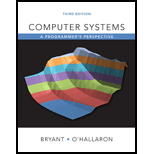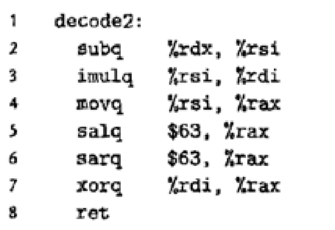
Concept explainers
For a function with prototype
long decoda2(long x, long y, long z);
GCC generates the following assembly code:

Parameters x, y, and z are passed in registers %rdi, %rsi, and %rdx. The code stores the return value in register %rax.
Write C code for decode2 that will have an effect equivalent to the assembly code shown.
Explanation of Solution
Given assembly code:
x in %rdi, y in %rsi and z in %rdx
decode2:
subq %rdx, %rsi
imulq %rsi, %rdi
movq %rsi, %rax
salq $63, %rax
sarq $63, %rax
xorq %rdi, %rax
ret
Load Effective Address:
- The load effective address instruction “leaq” is a variant of “movq” instruction.
- The instruction form reads memory to a register, but memory is not been referenced at all.
- The first operand of instruction is a memory reference; the effective address is been copied to destination.
- The pointers could be generated for later references of memory.
- The common arithmetic operations could be described compactly using this instruction.
- The operand in destination should be a register.
Data movement instructions:
- The different instructions are been grouped as “instruction classes”.
- The instructions in a class performs same operation but with different sizes of operand.
- The “Mov” class denotes data movement instructions that copy data from a source location to a destination.
- The class has 4 instructions that includes:
- movb:
- It copies data from a source location to a destination.
- It denotes an instruction that operates on 1 byte data size.
- movw:
- It copies data from a source location to a destination.
- It denotes an instruction that operates on 2 bytes data size.
- movl:
- It copies data from a source location to a destination.
- It denotes an instruction that operates on 4 bytes data size.
- movq:
- It copies data from a source location to a destination.
- It denotes an instruction that operates on 8 bytes data size.
- movb:
Comparison Instruction:
- The “CMP” instruction sets condition code according to differences of their two operands.
- The working pattern is same as “SUB” instruction but it sets condition code without updating destinations.
- The zero flag is been set if two operands are equal.
- The ordering relations between operands could be determined using other flags.
- The “cmpl” instruction compares values that are double word.
Unary and Binary Operations:
- The details of unary operations includes:
- The single operand functions as both source as well as destination.
- It can either be a memory location or a register.
- The instruction “incq” causes 8 byte element on stack top to be incremented.
- The instruction “decq” causes 8 byte element on stack top to be decremented.
- The details of binary operations includes:
- The first operand denotes the source.
- The second operand works as both source as well as destination.
- The first operand can either be an immediate value, memory location or register.
- The second operand can either be a register or a memory location.
Corresponding C code:
// Define method decode
long decode(long x, long y, long z)
{
// Declare variable
long tmp = y - z;
//Return
return (tmp * x)^(tmp << 63 >> 63);
}
Explanation:
- The register “%rdi” has value for “x”, register “%rsi” has value for “y” and register “%rdx” has value for “z”.
- The details of assembly code is shown below:
- The instruction “subq %rdx, %rsi” performs operation “y - z” and stores result in register “%rsi”.
- The statement “long tmp = y - z” corresponds to C code.
- The instruction “imulq %rsi, %rdi” multiplies result of operation with “x” and stores result in register “%rdi”.
- The statement “(tmp * x)” corresponds to C code.
- The instruction “movq %rsi, %rax” moves value in register “%rsi” to register “%rax”.
- The instruction “salq $63, %rax” performs left shift on value in register “%rax”.
- The statement “tmp << 63” corresponds to C code.
- The instruction “sarq $63, %rax” performs right shift on value in register “%rax”.
- The statement “tmp << 63 >> 63” corresponds to C code.
- The instruction “xorq %rdi, %rax” performs “XOR” operation on values in registers “%rax” and “%rdi”.
- The statement “return (tmp * x)^(tmp << 63 >> 63)” corresponds to C statement.
- The instruction “subq %rdx, %rsi” performs operation “y - z” and stores result in register “%rsi”.
Want to see more full solutions like this?
Chapter 3 Solutions
Computer Systems: A Programmer's Perspective (3rd Edition)
Additional Engineering Textbook Solutions
Database Concepts (8th Edition)
Degarmo's Materials And Processes In Manufacturing
Starting Out with C++: Early Objects (9th Edition)
Starting Out with C++ from Control Structures to Objects (9th Edition)
Starting Out with Java: From Control Structures through Data Structures (4th Edition) (What's New in Computer Science)
Java: An Introduction to Problem Solving and Programming (8th Edition)
- "Do not use AI tools. Solve the problem by hand on paper only and upload a photo of your handwritten solution."arrow_forward"Do not use AI tools. Solve the problem by hand on paper only and upload a photo of your handwritten solution."arrow_forward"Do not use AI tools. Solve the problem by hand on paper only and upload a photo of your handwritten solution."arrow_forward
- "Do not use AI tools. Solve the problem by hand on paper only and upload a photo of your handwritten solution."arrow_forwardSolve this "Do not use AI tools. Solve the problem by hand on paper only and upload a photo of your handwritten solution."arrow_forward"Do not use AI tools. Solve the problem by hand on paper only and upload a photo of your handwritten solution."arrow_forward
- "Do not use AI tools. Solve the problem by hand on paper only and upload a photo of your handwritten solution."arrow_forwardSpecifications: Part-1Part-1: DescriptionIn this part of the lab you will build a single operation ALU. This ALU will implement a bitwise left rotation. Forthis lab assignment you are not allowed to use Digital's Arithmetic components.IF YOU ARE FOUND USING THEM, YOU WILL RECEIVE A ZERO FOR LAB2!The ALU you will be implementing consists of two 4-bit inputs (named inA and inB) and one 4-bit output (named out). Your ALU must rotate the bits in inA by the amount given by inB (i.e. 0-15).Part-1: User InterfaceYou are provided an interface file lab2_part1.dig; start Part-1 from this file.NOTE: You are not permitted to edit the content inside the dotted lines rectangle. Part-1: ExampleIn the figure above, the input values that we have selected to test are inA = {inA_3, inA_2, inA_1, inA_0} = {0, 1, 0,0} and inB = {inB_3, inB_2, inB_1, inB_0} = {0, 0, 1, 0}. Therefore, we must rotate the bus 0100 bitwise left by00102, or 2 in base 10, to get {0, 0, 0, 1}. Please note that a rotation left is…arrow_forwardSolve this "Do not use AI tools. Solve the problem by hand on paper only and upload a photo of your handwritten solution."arrow_forward
- Solve this "Do not use AI tools. Solve the problem by hand on paper only and upload a photo of your handwritten solution."arrow_forward"Do not use AI tools. Solve the problem by hand on paper only and upload a photo of your handwritten solution."arrow_forwardSolve this "Do not use AI tools. Solve the problem by hand on paper only and upload a photo of your handwritten solution."arrow_forward
 C++ for Engineers and ScientistsComputer ScienceISBN:9781133187844Author:Bronson, Gary J.Publisher:Course Technology Ptr
C++ for Engineers and ScientistsComputer ScienceISBN:9781133187844Author:Bronson, Gary J.Publisher:Course Technology Ptr C++ Programming: From Problem Analysis to Program...Computer ScienceISBN:9781337102087Author:D. S. MalikPublisher:Cengage LearningCOMPREHENSIVE MICROSOFT OFFICE 365 EXCEComputer ScienceISBN:9780357392676Author:FREUND, StevenPublisher:CENGAGE L
C++ Programming: From Problem Analysis to Program...Computer ScienceISBN:9781337102087Author:D. S. MalikPublisher:Cengage LearningCOMPREHENSIVE MICROSOFT OFFICE 365 EXCEComputer ScienceISBN:9780357392676Author:FREUND, StevenPublisher:CENGAGE L Microsoft Visual C#Computer ScienceISBN:9781337102100Author:Joyce, Farrell.Publisher:Cengage Learning,
Microsoft Visual C#Computer ScienceISBN:9781337102100Author:Joyce, Farrell.Publisher:Cengage Learning, EBK JAVA PROGRAMMINGComputer ScienceISBN:9781337671385Author:FARRELLPublisher:CENGAGE LEARNING - CONSIGNMENT
EBK JAVA PROGRAMMINGComputer ScienceISBN:9781337671385Author:FARRELLPublisher:CENGAGE LEARNING - CONSIGNMENT Systems ArchitectureComputer ScienceISBN:9781305080195Author:Stephen D. BurdPublisher:Cengage Learning
Systems ArchitectureComputer ScienceISBN:9781305080195Author:Stephen D. BurdPublisher:Cengage Learning





